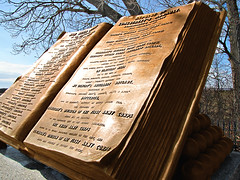 Image by Soaptree via Flickr
Image by Soaptree via FlickrA narrative I found on the internet by the 53rd Mattoponi Guards. They are an reenactment group. I will be attaching that site on my index at the end of Henry Ward story.
A few miles to the east, on July 1, The Battle of Gettysburg began. All units were called to concentrate on that point. Pickett’s division, still being stationed near Chambersburg, began moving according to orders. They began their 28 mile march about 2 a.m. on the 2nd, and arrived near Gettysburg around 5p.m. They halted about three miles short of the town, near Marsh Creek, being very worn down from the forced march. Meanwhile, close by, the second day of fighting was still raging. Places such as Little Round Top, the Peach Orchard, and Devil’s Den were becoming infamous sites of destruction and death. After what would the final night of many men’s lives, Pickett’s division was ordered early on the 3rd to the center of the Confederate line, located on Seminary Ridge The 53rd was posted along a tree line, part of Spangler’s Woods, somewhat protected from the rising temperature of the day. A little over a mile from there was the Union line, located along Cemetery Ridge.
General Lee had chosen Pickett’s division, the freshest available, along with the divisions of Pettigrew and Trimble, to assault the center of the Federal line. Those divisions, numbering between 10-12 thousand men, were to break the Union line, concentrating on the now-famous copse of trees as the target point.
Preceding the attack, Lee had Colonel Porter Alexander unleash a huge bombardment by more than 120 cannons against the Union center. This began at 1 p.m. Union artillery responded as best as possible. During this barrage, Colonel Aylett was wounded and taken from the field. He would take part in the coming attack, but he would fight another day. Lot Colonel Rawley Martin would lead the 53rd in the coming attack.
About 2:30 p.m., Alexander observed Union artillery pulling back, falsely believing the Union batteries were being driven off. After Pickett received Longstreet’s infamous half-hearted, wordless approval, the order was given to move forward. Pickett’s division stepped off about 3p.m. The two brigades of Garnett to the left and Kemper to the right led the way. Armistead’s brigade, the largest of the three, followed behind Garnett and the left of Kemper. The 53rd was posted in the middle of the five regiments with the colors.
A terrible storm of artillery fire fell on the advancing Confederates. Pickett’s division, while being under this heavy fire, had to perform a series of left obliques to align themselves with Pettigrew’s division. By the time Garnett and Kemper reached the Emmitsburg Road, musket fire from the Federals also started to claim casualties. The rail fences along the road slowed the confederate advance and also caused more organizational disintegration. As the first line moved beyond the road, Union troops to the north and south began pouring fire on the flanks, narrowing the Confederate advance. Garnett was soon dead and Kemper seriously injured. Armistead’s brigade had managed to keep its formation, being the second line. As the two brigades began to disintegrate in front of him, and his own brigade beginning to receive heavier fire, Armistead decided to push forward and attempt to go over the Federal line. With his black hat on the end of his sword and Lt. Colonel Martin next to him, Armistead lead an inspired advance.
It was about 3:30 p.m. The Confederates had advanced a mile in open ground, under heavy fire nearly the whole time. With Armistead a few steps ahead, between 150-500 Confederates managed to go over the stone wall which marked the Union line, near the copse of trees. Although the initial line of federals were routed, other units quickly poured in. Desperate hand to hand fighting took place. Both Armistead and Martin were wounded, the former mortally. He fell next to one of the temporarily captured guns of Cushings Battery. Fighting continued for a few minutes more, but union forces gained the upper hand. The remains of the divisions of Pickett, Pettigrew and Trimble began the retreat, under fire the whole way once again. This attack marked the “High Water Mark of the Confederacy” The flag of the 53rd made it the farthest, being captured near Armistead. The other regiment colors of the 9th, 14th, 57th and 38th Va, were also captured. Pickett lost half of his 6,500 men that day, and never forgave General Lee. Out of 466 effectives, the 53rd had 213 killed, wounded and captured.
Robert Adams Ward was serving with the 53rd under Captain Tredway and Colonel Martin. One of the many Pittsylvania County men that fought their way to the stone wall during that bloody hour. It must have been between 3:00 p.m. and 4:00p.m. when he lost his life in battle. Did he make it over the stone wall? I do not know. But I do know this that several newspaper articles were written during the anniversary of Gettysburg while there were still veterans to tell the tale. And from both the Union and the Confederacy the same story was always true about the bravery of the regiment as they marched across the battlefield and into history.
Other engagements of the 53rd during the time Robert Adams Ward served:
Yorktown Siege April-May 1862
Williamsburg May 5, 1862
Seven Pines May 31-June 1, 1862
Kings School House June 25, 1862
Malvern Hill July 1, 1862
2nd Bull Run August 28-30, 1862
South Mountains September 14, 1862
Antietam September 17, 1862Shepherdstown Ford September 20, 1862
Fredericksburg December 13, 1862
Suffolk Campaign April-May, 1863
Gettysburg July 1-3, 1863
Tips for the researcher:
After my article on both brothers that served in the Civil War, I will include the websites I found on the internet which were very helpful.
If you think that you may have an ancestor that served in the civil war, there are many websites which can be very helpful. Especially those that I am including with the Henry Ward article.
Other avenues which are very helpful:
The library – Most libraries have a genealogy section. This can get you started. There are always numerous books about different battles and generals. I have just ordered from the library a book that I found while researching. The name of the book is Brigades of Gettysburg: The Union and Confederate Brigades at the Battle of Gettysburg by Bradley Gottfried. Apparently this gives a detailed description of each brigade. If you have been doing research and you know what regiment your ancestor served then you can follow your ancestor through battle.
Graveyards – If you still live in the area of your family’s origins, then ask older family members about locations of family burial grounds. Some of the gravestones will have the regiment or what war in which they served and birth and death dates.
Keeping in mind your family member’s birthdates will help you resolve confusion on who is who. If you are a beginner in family research, you are probably noticing that everyone seems to have the same name. It was common practice before the twentieth century to have the middle name of your mother’s family and there is always a son with the father’s name. Also, infant mortality was very high. So one child with a name may die and later another child will be named the same name. Remember there are no movie stars names for children back then. After the revolutionary war, quite a few family members will have the name of George Washington or Thomas Jefferson. They were the rock stars of their generation.
The sons of William Walker Ward and Elizabeth Mumford Adams
Robert Adams Ward, born January 6, 1840; was killed at Gettsyburg on July 3, 1863.
Pvt. Robert Ward enlisted on November 1, 1861 at Deep Creek, Virginia in the 53rd Va. Infantry, Chatham Greys.
I have a copy of a letter from the Office of Pay Master General of Virginia dated March 17th, 1865 to Mrs. Eliza M. Ward:
Madam:
Yours of the 27th came to hand this morning and in reply I will state that the only evidence I have of the death of your son R. A. Ward is contained in an official final statement from his Captain W. M. Tredway Jr. commanding Company I 53rd Va. Infantry. Some time since I wrote to Capt Tredway to send me this final statements (or accounts) of all deceased soldiers belonging to his company he did so and that is how I came by the final statement of your son. On each final statement is given the name of the claimant so that I can write to the representatives for the necessary papers to be executed by them for the settlement of said claims. It will be necessary for you to execute the paper I sent you on the 14th. No other papers are needed unless it be a power of attorney which I may have neglected to send you before. I enclose herewith a __. The official report of the Captain shows that your son was killed in action on July 3, 1863.
Very respectfully Your Obedient Servant Henry Hill Paymaster General.












No comments:
Post a Comment